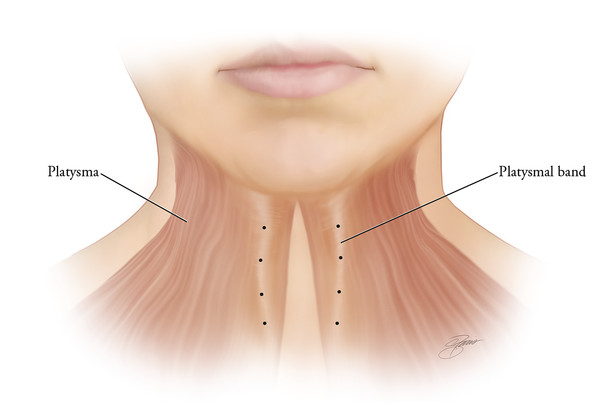Platysma bands are vertical lines or cords that become prominent in the neck region with age. These visible structures are due to the contraction, separation, or hypertrophy of the platysma muscle, a superficial sheet-like muscle extending from the jawline down to the upper chest. The appearance of these bands is often associated with skin laxity, muscle atrophy, and a decline in collagen production, contributing to an aged or “turkey neck” appearance.

Anatomy of the Platysma Muscle: A Closer Look
The platysma muscle plays a critical role in the movement of the lower face and neck. Originating from the upper portion of the chest and shoulder and inserting into the lower face, this muscle is responsible for pulling the corners of the mouth downward and contributing to expressions of sadness or tension.
As we age, the platysma may lose its elasticity and begin to separate at the midline, forming two vertical cords—commonly referred to as platysma bands—that protrude during muscle contraction and are especially visible during speech or expression.
Causes of Platysma Banding: Why It Happens
Natural Aging Process
Collagen degradation, elastin loss, and declining skin hydration cause skin laxity, allowing the platysma muscle fibers to become more visible. The muscle itself may also become more prominent with age due to atrophy or hypertrophy in isolated sections.
Genetic Predisposition
Some individuals naturally have more active or hypertrophic platysma muscles, predisposing them to early or more pronounced banding. Thin-skinned individuals or those with low body fat may notice banding earlier.
Repetitive Facial Expressions
Overuse of the platysma muscle due to habitual movements—such as exaggerated facial expressions or frequent clenching of the jaw—can lead to increased muscle tone and visible banding over time.
Lack of Neck Muscle Support
Poor posture, tech neck (frequent downward gazing at devices), and lack of muscle toning exercises can weaken the support system of the neck, allowing the platysma to separate and sag.
Symptoms and Signs of Platysma Bands
- Vertical lines or cords visible from the jawline down the neck
- Bands that become more prominent during speech or facial movements
- Sagging skin between bands, enhancing the “turkey neck” effect
- Reduced definition of the jawline and cervicomental angle
- Skin wrinkling and creasing around the neck
Non-Surgical Treatments for Platysma Bands
Botulinum Toxin (Botox) Injections
Botox is the first-line non-surgical treatment for platysma bands. It works by temporarily paralyzing the platysma muscle, reducing its ability to contract and thus softening the appearance of vertical bands.
Advantages:
- Minimally invasive
- Quick procedure with no downtime
- Results visible within 7–14 days
- Lasts 3–4 months
Limitations:
- Temporary effect; requires maintenance
- Less effective in severe cases or with significant skin laxity
Dermal Fillers and Skin Tightening Treatments
In cases where platysma bands are accompanied by significant volume loss or laxity, dermal fillers can provide support and lift. Additionally, non-invasive tightening technologies like radiofrequency (RF), ultrasound (Ultherapy), or laser treatments can stimulate collagen production and tighten loose skin.
Surgical Options: Long-Term Correction of Platysma Bands
Platysmaplasty
Platysmaplasty is a targeted surgical procedure that addresses platysma banding by modifying the muscle structure. It involves either suturing the separated muscle edges together at the midline (anterior corset platysmaplasty) or removing a portion of the muscle to reduce banding.
Procedure Details:
- Typically performed under local anesthesia with sedation or general anesthesia
- Incisions are hidden under the chin or behind the ears
- Can be combined with liposuction or a facelift for comprehensive rejuvenation
Neck Lift (Lower Rhytidectomy)
A neck lift is a more extensive surgical solution that repositions deeper tissue structures, removes excess skin, and tightens the platysma to restore a youthful neck contour.
Benefits:
- Long-lasting results (often 10+ years)
- Improved jawline definition
- Comprehensive rejuvenation of neck and lower face
Considerations:
- Requires recovery time (7–14 days)
- Higher cost than non-invasive treatments
- Best for candidates with significant skin laxity and muscle separation
Prevention and Maintenance Strategies
Neck Exercises and Posture Correction
Consistent neck strengthening and stretching routines can improve muscle tone and delay the onset of visible banding. Good posture reduces the strain on the platysma and prevents premature sagging.
Skincare for Neck Health
Using topical products with peptides, retinoids, and hyaluronic acid can enhance skin firmness and hydration, thereby reducing the prominence of early bands.
Sun Protection
Ultraviolet radiation accelerates skin aging. Daily sunscreen use on the neck and décolletage is essential in preserving elasticity and preventing premature aging signs.
Choosing the Right Treatment for Platysma Bands
Treatment choice depends on the severity of the banding, skin quality, patient age, and aesthetic goals. A thorough consultation with a board-certified dermatologist or plastic surgeon is critical in crafting a customized treatment plan.
| Treatment | Invasiveness | Downtime | Duration of Results | Ideal Candidate |
|---|---|---|---|---|
| Botox Injections | Low | None | 3–4 months | Mild to moderate banding |
| Ultherapy/RF | Low | Minimal | 6–12 months | Mild laxity, early aging signs |
| Platysmaplasty | Moderate | 1–2 weeks | 5–10 years | Moderate to severe muscle banding |
| Neck Lift | High | 2 weeks | 10+ years | Severe laxity and visible aging |
Platysma bands are a common and aesthetically significant sign of neck aging. Whether opting for minimally invasive approaches such as Botox or undergoing surgical correction through platysmaplasty or a neck lift, patients today have access to highly effective solutions. An integrated approach that includes prevention, targeted treatments, and professional guidance ensures optimal outcomes and sustained neck rejuvenation.